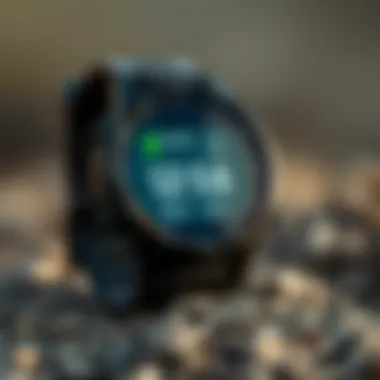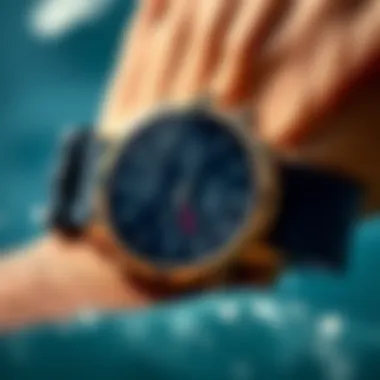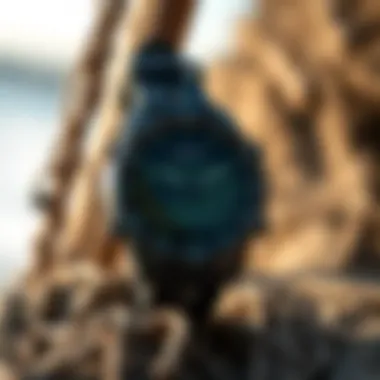Garmin Solar Watch Review: Features and Performance Analysis


Intro
In a world where technology intertwines seamlessly with our daily lives, the Garmin Solar Watch stands as a beacon for those who seek adventure both in the great outdoors and in the realms of fitness tracking. This remarkable piece of equipment captures the spirit of exploration, merging the age-old artistry of watch craftsmanship with innovative solar energy capabilities. It's not just a watch; it's a companion for athletes and outdoor enthusiasts alike.
As we delve into the nitty-gritty of this solar-powered marvel, we’ll explore its performance, usability, and the practical benefits it offers to users that live life on the edge—especially surfers. From assessing its durability to gauging its effectiveness under various conditions, this comprehensive review aims to shed light on whether the Garmin Solar Watch truly lives up to the hype.
Key features will be unraveled, illustrating how they contribute to the overall user experience, particularly for wind-battered athletes carving through waves. Its design, versatility, and added solar functionality promise to transform how adventurers interact with technology. More importantly, we’ll dissect both its advantages and shortcomings, striving to empower potential buyers to make informed decisions before they leap into action with this cutting-edge piece of technology.
Thus, let us embark on this expedition, illuminating the depths of the Garmin Solar Watch's capabilities and determining if it can indeed withstand the rigors of an outdoor lifestyle.
Preface to Garmin Solar Watch
The Garmin Solar Watch stands at the intersection of technology and outdoor adventure. As a piece of wearable tech designed for those who spend their lives on the go, it appeals to a diverse audience. From recreational surfers looking to ride the perfect wave to instructors who require robust tools for safety and navigation, this watch covers a myriad of needs. Understanding not just its features but its practical implications can significantly affect one’s outdoor experiences.
In the realm of outdoor gear, durability and functionality are of utmost importance. The Garmin Solar Watch ticks these boxes, allowing users to not only monitor their activities but also harness the power of the sun through solar charging technology. This feature is crucial for anyone who enjoys prolonged periods outdoors—an essential aspect that separates this watch from others in its category. It's designed for those who might find themselves in unpredictable environments, ensuring they have a reliable companion on their wrist, whether they're kayaking, hiking, or engaging in more extreme sports.
Benefits of the Garmin Solar Watch
The benefits of the Garmin Solar Watch are twofold: it combines advanced technological capabilities with a high degree of practicality.
- Long-lasting Battery Life: The ability to charge via solar power extends battery life significantly, catering to outdoor enthusiasts who often find themselves away from conventional charging options.
- Fitness Tracking: Beyond telling time, the watch continuously tracks physical activity and provides insights on health metrics, offering users a clearer picture of their well-being.
- Durability for Outdoor Use: Designed with rugged materials that withstand heavy use, it's weatherproof and impact-resistant, making it a reliable tool in various conditions.
Considerations About the Watch
While the Garmin Solar Watch carries numerous advantages, potential users should consider the following:
- Learning Curve: The multitude of features might be overwhelming for some. Proper familiarization with the various functionalities is necessary to maximize its potential.
- Price Point: As with many high-end gadgets, the initial investment can be significant, but understanding long-term benefits can justify the cost.
In summary, the Garmin Solar Watch is much more than a timepiece; it's a gateway to enhanced outdoor experiences. It speaks to those who seek not only adventure but also precision and reliability in their gear. By examining its features further, readers can ascertain if this watch aligns with their needs and lifestyle. Understanding this aspect sets the tone for the detailed exploration that follows in this review.
Design and Aesthetics
When it comes to wearable technology, the design and aesthetics of a watch are not mere embellishments; they play a pivotal role in how users perceive and interact with the device. The Garmin Solar Watch promises not just functionality, but also a look that appeals to both casual wearers and serious athletes. This section dives into the watch’s craftsmanship through choices of materials, the array of color variants, and how ergonomics factor into everyday use.
Materials Used
Case Material
The case material is one of the first things a potential buyer will notice. With the Garmin Solar Watch, it’s often made from fiberglass-reinforced polymer, which underlines a key characteristic: durability. This material holds up remarkably well against the rigors of outdoor activities, giving users the peace of mind they crave.
What's particularly telling about the fiberglass-reinforced polymer is its impressively low weight coupled with substantial strength. Users find this a beneficial choice for day-to-day wear, as the lightness prevents that drag you often feel with metal cases. One unique feature of this case material is its resistance to temperature fluctuation—perfect for surfers or outdoor adventurers who may encounter extreme weather. However, while the material is sturdy, it may lack the premium feel that metal often exudes.
Strap Options
The Garmin Solar Watch offers varied strap options, typically crafted from silicone or woven nylon. These materials bring a key characteristic worth highlighting: comfort. Silicone straps are particularly popular because they are soft against the skin and resistant to wear, making them a great choice in a sweaty, humid environment. The woven nylon options, on the other hand, appeal to those looking for something with a bit of flair while still providing comfort.
A unique feature of the strap choices is their quick-release mechanism. This allows users to effortlessly switch between styles, adapting to different occasions—from surfing in the ocean to casual outings. The only caveat? Some wearers might find the nylon straps to feel heavier over time, which could affect overall comfort during extended use.
Display Quality
When you're outdoors, visibility is crucial, and this is where the display quality of the Garmin Solar Watch shines. It features a sunlight-readable display, ensuring users can see important metrics even in direct sunlight. The high resolution presents data in a clear and vibrant way, enhancing user experience dramatically.
One of the unique features of this display is its always-on functionality, which allows users to glance at their stats without a cumbersome button press every time the wrist is turned. Although this feature is a plus, a trade-off exists in battery consumption—if not managed correctly, it could lead to more frequent charging.
Color Variants
Standard Colors
The watch comes in standard colors like black, gray, and navy blue, appealing to those who prefer a more understated look. These classic hues are not just visually appealing; they are extremely functional as they tend to hide dirt and imperfections better than lighter colors. This choice can make a significant difference for users engaged in outdoor activities who wish to keep their gear looking sharp.
However, the simplicity of the standard colors might not excite everyone. Some outdoor enthusiasts seek bolder colors to express their adventurous spirit, and thus might feel a bit let down by the conservative palette.
Limited Editions
For those looking to stand out, the Garmin Solar Watch offers various limited editions that cater to niche markets and special interests. These editions often come in colors and styles that reflect unique themes or collaborations, making them a strong choice for collectors.
The unique feature of limited editions is their often distinct design elements—like custom graphics or patterns that tell a story. Unfortunately, the downside could be the price point, which is typically higher, and their scarcity leading to missed opportunities for some potential buyers.
Ergonomics
Comfort During Use
Comfort is not merely about how a watch feels on the wrist; it significantly affects the overall user experience. The Garmin Solar Watch is designed with padding and adjustable components to offer excellent comfort. Having been engineered to conform to the wrist's natural contour, users often find they can wear the watch for long durations without discomfort.
This attention to comfort makes the watch a favorable choice for athletes and outdoor adventurers, as they can rely on it for extended periods without constant readjustment or annoyance. However, some users might find that those layers of padding can make the watch feel warmer, especially on hot sunny days.
Weight Distribution
Another crucial factor contributing to overall comfort is weight distribution. The Garmin Solar Watch's design ensures that it doesn't feel top-heavy. Instead, the balance between the case and strap is meticulously engineered for a snug fit that feels secure without being constrictive.
The unique feature here is that this balanced design can cater to various wrist sizes, making it one-size-fits-all in a way that most people can appreciate. However, if the watch is loaded with too many features, it might start to feel heavier over time, which could detract from the initial comfort level when first worn.


"The design and aesthetics of the Garmin Solar Watch are not just about looks; they're about functionality, comfort, and the overall outdoor experience that it aims to enhance."
Technical Features
Understanding the technical features of the Garmin Solar Watch is crucial, particularly for outdoor enthusiasts who depend on precision and functionality in demanding environments. These features not only augment the watch’s capabilities but also enhance user experience.
Among various technical aspects, features like solar charging technology, GPS accuracy, and health tracking functionalities play pivotal roles, ensuring that users can rely on this device through various adventures, be it surfing or hiking.
Solar Charging Technology
Efficiency
When discussing efficiency, one must consider how effectively the solar panels convert sunlight into usable energy. Garmin has engineered this solar technology to harness even low light, making it a standout choice for outdoor enthusiasts. Instead of being dependent solely on conventional charging methods, this technology allows the watch to maintain power for extended periods.
A key characteristic of this efficiency is its adaptive charging, which means that the watch adjusts its power management based on usage, prioritizing essential functions. However, one must note that while efficiency is impressive, full reliance on solar charging may not suit every environment, especially in areas with limited sunlight.
Charging Timelines
Turning to charging timelines, we see how solar technology influences not just energy consumption but also charging duration. Users generally benefit from faster charging in bright sunlight, with full charges achieved in just a few hours under optimal conditions. This represents a great advantage for those who need quick power replenishment in the field.
The unique feature here is the hybrid approach; when solar power runs low, the watch can still draw from more traditional power sources. This dual capability ensures that users aren’t stranded in low daylight conditions, though one has to plan for possible delays in charging from solar alone during overcast days or indoor settings.
GPS and Navigation Systems
Navigation Accuracy
Navigation accuracy is a keystone feature of any GPS-enabled device, particularly for surfers who rely on precise positioning for catching waves. Garmin touts frequent updates and a sophisticated satellite reception system that considerably enhances accuracy, especially in tricky coastal areas. This accuracy can mean the difference between a successful outing or drifting off-course.
A notable characteristic is the multi-band GNSS technology employed, which allows for more reliable positioning in challenging environments, such as urban jungles or steep cliffs. While accuracy largely benefits outdoor activities, improper calibration or settings may lead to inaccuracies, highlighting the importance of user familiarity with the device.
Map Integration
In terms of map integration, Garmin excels with its proprietary software that works seamlessly with the watch's interface. This feature not only allows users to download essential maps but also update them easily, keeping all navigational tools current and functional.
Such integration champions a significant advantage when hitting remote surf spots or backcountry trails where conventional means of navigation may falter. However, dependence on map integration means that users must ensure they have sufficient battery life and data plans to keep maps updated—a consideration not to be overlooked.
Fitness and Health Tracking
Heart Rate Monitoring
The inclusion of heart rate monitoring in the Garmin Solar Watch integrates health tracking into the athletic experience. Using photoplethysmography, this technology accurately tracks heart rates during activities, a feature crucial for athletes looking to gauge their exertion levels.
This characteristic becomes particularly beneficial when surfing, as it allows for real-time feedback on one’s physical condition in the water. Yet, it is important to acknowledge that while heart rate data is valuable, fluctuations due to water immersion might introduce errors at times, hence it should be used as a supportive tool rather than an absolute metric.
Sleep Tracking
Finally, sleep tracking offers wearers insights into their recovery processes, providing feedback on sleep quality and duration. By analyzing movement patterns and heart rates, users receive a comprehensive overview of their sleep health.
The watch’s intuitive interface makes reviewing this data straightforward, enhancing its appeal to life beyond physical activity. However, as with any tech, a degree of inaccuracy might exist, especially for users who have inconsistent sleep routines, noting that it may take time for the watch to adjust to a new user's patterns.
Performance Analysis
When assessing the Garmin Solar Watch, performance analysis plays a crucial role. It's not just about how the watch looks or its feature set; it’s about how well it performs in real-world settings. This section delves into various aspects, including battery life and overall user experience. These components not only define the watch's functionality but also determine if it meets the rigorous demands of outdoor enthusiasts, particularly surfers and athletes.
Battery Life Comparisons
Under Regular Use
Under regular use, the Garmin Solar Watch showcases its prowess with respectable battery longevity. Typically, users find that with standard functions activated—such as heart rate monitoring, notifications, and GPS usage—the watch provides a solid battery life that stretches across several days. This characteristic is widely appreciated, as many outdoor enthusiasts prefer a device that lasts without requiring daily charging.
One unique feature of the regular use battery life is its ability to adapt. For instance, different modes influence the consumption levels; when engaged in activities like hiking, the battery might deplete faster due to frequent GPS updates. However, this flexibility can be an advantage, allowing the wearer to choose between performance and longevity based on their immediate needs.
Such a feature can also lead to some trade-offs. Users who rely heavily on GPS may find the battery runs dry faster than expected, especially during extended activities. This highlights a potential drawback for high-endurance users who require constant tracking capabilities.
Under Solar Charging Conditions
On solar charging conditions, the performance of the Garmin Solar Watch takes an impressive leap forward. Utilizing the innovative solar technology, the watch can sustain its battery life when exposed to sunlight. This means that during a typical day's outing—whether surfing or trekking—a user can potentially see prolonged usage, diminishing the frequency of traditional charging.
The standout feature here is how effectively the solar panels charge even in varying light conditions. Many find it beneficial, especially those who spend considerable time outdoors under the sun. This feature allows outdoor athletes to stay on the go without worrying about their watch's power running out unexpectedly.
However, as with most things that shine in theory, there can be hiccups. The level of charging efficiency can fluctuate based on overcast conditions or shorter winter days. Users may need to plan accordingly, as those dimmer days could lead to energy shortages if they rely too heavily on solar power alone.
User Experience
Ease of Use
Ease of use is another critical aspect when evaluating the Garmin Solar Watch. The user interface is designed to be intuitive—a necessity for athletes who need to access information quickly during active routines. Users often appreciate how straightforward the navigation is, allowing even the least tech-savvy individuals to dive straight into action without fumbling around.
A unique aspect of this watch is its customizable interface, enabling wearers to tailor it according to their preferences. This customizable feature can be a boon for surfers who need quick access to tide information or wave heights. In comparison, it can also serve more casual users who may only need basic timekeeping functionalities.
That said, some might find that certain features could take some getting used to. While the main functions are easily accessible, the more advanced options may require a bit of a learning curve initially.
Interface Responsiveness


The interface responsiveness of the Garmin Solar Watch significantly impacts the overall user experience. Quick, deliberate interactions are what users expect, and this watch is designed to deliver just that. Button presses or touch interactions yield immediate responses, making it easy to shift between functions while on the run.
This swift responsiveness correlates well with the demands of outdoor sports. For surfers who might need to record conditions rapidly or track their performance in real-time, a responsive interface becomes indispensable. The smooth transitions and rapid access to key metrics provide an edge that is often felt during critical moments.
However, not everyone experiences a faultless interaction. Occasionally, certain features may lag depending on the mode of operation, especially when multiple functions are activated simultaneously. For instance, combining heavy GPS usage with media notifications might slow things down a notch.
Durability and Water Resistance
When diving into the world of outdoor wearable technology, the Durability and Water Resistance of a watch plays a significant role, especially for those who spend considerable time in extreme environments. The Garmin Solar Watch is engineered with these factors in mind, making it a suitable companion for surfers, lifeguards, and outdoor athletes. Its robustness ensures that adventurers can rely on their gear, regardless of unexpected weather shifts or demanding activities.
Testing Conditions
Impact Resistance
Impact resistance stands as a critical factor when evaluating a watch meant for rugged use. The Garmin Solar Watch boasts a construction that can withstand drops and knocks, whether it's from a wipeout on the waves or a sudden slip on rocky trails. This key characteristic helps prevent malfunction or physical damage, which is essential for those who lead an active lifestyle.
A notable feature of the impact resistance is the flexible polymer casing combined with reinforced glass. Such materials not only shield against common abrasions but also keep the watch lightweight, which is beneficial in reducing fatigue during prolonged wear. Therefore, whether you're crashing through surf or navigating rough terrain, you can have peace of mind knowing your watch can take a beating.
Waterproof Ratings
The waterproof ratings of the Garmin Solar Watch are another pivotal aspect worth mentioning. Designed with immersion in mind, it is rated for water resistance up to 100 meters, allowing for confident use in both surfing and swimming situations. This key characteristic emphasizes the versatility of the watch, whether you need to dive into the waves for a quick session or simply splash around with friends.
Additionally, the unique feature of having a waterproof touchscreen enhances usability in wet conditions. Navigating through features remains seamless, even if your hands are dripping with sea water. However, it’s essential to note that while the watch resists water, submersion in high-pressure water, such as scuba diving, could still potentially pose risks, and one should be cautious in those situations.
Long-Term Durability
Corrosion Resistance
When talking about long-term durability, corrosion resistance is a prime consideration, especially for those who live near the ocean or frequently come into contact with salty water. The Garmin Solar Watch is built with materials designed to resist corrosion, such as stainless steel and specialized coatings. This key characteristic is beneficial because it allows the watch to maintain its aesthetic appeal without rusting or degrading from salty air or water exposure.
A notable advantage of this corrosion resistance is in longevity; users can expect their watch to remain functional and looking good far longer than competitors lacking these qualities. However, if the watch is not properly maintained, even the most resistant materials can succumb to environmental factors over time. Regular cleaning can help extend the lifespan of the watch considerably.
Component Longevity
Finally, component longevity is vital for users who demand a reliable device day in and out. The internal components of the Garmin Solar Watch, including the battery and sensors, are crafted to withstand extensive use without significant degradation. This key characteristic means that surfers and outdoor enthusiasts can expect the watch to deliver accurate readings and functions for multiple seasons.
Additionally, features like replaceable straps enhance the watch’s lifespan further. Users can easily swap out worn straps for fresh ones, maintaining functionality and comfort. Nevertheless, it's worth mentioning that while individual components may last long, the overall longevity may depend on how hard one pushes the watch in the field. Regular inspections can help keep everything running smoothly and avoid any unpleasant surprises during a surf session.
Suitability for Surfing and Outdoor Sports
The Garmin Solar Watch holds a special place in the hearts of surfers and outdoor enthusiasts. Its design and functionality cater specifically to those who thrive in nature, making it essential to discuss its suitability for activities like surfing. Factors such as durability, solar-charging features, and targeted functionalities contribute greatly to its appeal. This watch doesn't just act as a timepiece; it’s a tactical companion for navigating the waves and wilderness.
Features Beneficial to Surfers
Wave Height Monitoring
When it comes to catching that perfect wave, having the right data at your fingertips can change the game. The Wave Height Monitoring feature on the Garmin Solar Watch allows surfers to access real-time information about wave sizes. This function ensures you're not paddling out into conditions that are beyond your skill level. One of the standout characteristics of this feature is its accuracy. It utilizes a combination of GPS and satellite data to provide precise measurements, giving surfers a leg up when planning their sessions.
The real benefit here is not just access to data; it’s knowing how to use it. Experienced surfers can align their decision-making with the information provided, optimizing their time in the water. However, it’s crucial to consider that the accuracy of wave height can vary based on local conditions or sensor precision.
Tide Tracking
Another critical aspect of surfing is having an understanding of the tides. The Tide Tracking feature on this Garmin watch is a game-changer for surfers. Knowing when to ride the waves is pivotal, and this function makes it easy. The watch displays tide data for various locations, which is crucial for planning your day at the beach.
What makes this feature particularly useful is its user-friendly interface. You can set up notifications and view tide charts in a few quick taps. This not only saves time but also helps you stay informed about the changing conditions. However, keep in mind that tide patterns can differ, so relying solely on one data source may not be wise due to potential local variances.
User Testimonials
Surfers’ Experiences
Personal accounts from surfers who’ve used the Garmin Solar Watch provide real insight into its efficacy. Many users praise the watch for its accuracy and reliability. Surfers often highlight how features like wave monitoring and tide tracking helped them select the right days for surfing.
One standout testimonial talks about a surfer who caught their best wave yet after getting actionable data from the watch. Such stories underscore the watch's role in enhancing memorable experiences on the water. That said, some users mention a learning curve when first adapting to the functionalities. Still, this initial struggle often gives way to a smoother experience later on.
Feedback from Outdoor Enthusiasts
Beyond surfing, the Garmin Solar Watch has garnered positive reactions from outdoor enthusiasts—hikers, campers, and nature photographers alike. Users frequently note the durability and long battery life under challenging conditions. One user, a marine biologist, mentioned how the solar charging kept them connected in remote areas where power sources were scarce.
This versatility is appealing as it means the watch isn't just a niche tool. However, some feedback indicates that while the watch excels in many terrains, unpredictable weather can still affect its performance, particularly functionality reliant on GPS. Thus, while the watch generally shines in its application, being aware of the environment remains crucial.
Customer Support and Warranty
When investing in a Garmin Solar Watch—or any high-tech gadget, really—the little things like customer support and warranty can mean the difference between a good experience and a frustrating one. In this section, we will explore how Garmin’s customer support and warranty offerings stack up. After all, being able to lean on a solid support system is just as crucial as the watch’s functions themselves, especially for outdoor enthusiasts.
Excellent Customer Service
Quality customer service is a hallmark of any reputable brand. For Garmin, this manifests in their commitment to help customers navigate any issues or concerns they might run into. Keeping outdoor adventurers happy is key, as gear can often face challenging conditions.
Return Policies
Garmin’s return policies are notably generous. The return window is typically set at 30 days, offering individuals ample time to test the watch in real-world conditions. This grace period is designed to boost buyer confidence, allowing users to ensure that this gadget truly meets their nautical or sporting needs.


One of the standout features of their return policy is the ease of the process. Users can initiate returns online, which saves time, compared to some brands that require you to jump through hoops before you can return. However, be aware of the fact that returned items should be in original condition complete with packaging to qualify for a full refund. This requirement can sometimes present a slight inconvenience to users who have already put the watch through its paces during sporting activities.
Support Channels
Having accessible support channels is critical for a brand like Garmin, which caters to a tech-savvy audience. Garmin provides multiple ways for customers to reach out for support. Users can opt for online chat, email, or even pick up the phone for direct assistance. This range of options caters to different preferences—some folks might want immediate answers via chat while others might prefer a more detailed dialogue over a phone call.
The unique feature of Garmin’s support system is the extensive online resource library they offer. This includes FAQs, user manuals, and troubleshooting guides. Perhaps not every device can boast this level of support. However, one downside might be the response time during peak seasons, which could leave some users hanging when time is of the essence.
Warranty Coverage
Warranty coverage is another critical aspect to consider when purchasing a smartwatch, particularly for those who plan to take it into the wild.
Duration
Garmin offers a standard one-year warranty on their Solar Watch, which is a fairly industry-standard assurance. This timeframe allows users to gauge the long-term performance of the watch, covering structural defects that could arise from daily usage.
A notable characteristic of this duration is its straightforward nature; there are no fancy gimmicks or complicated terms that typically accompany prolonged warranty periods. On the flip side, while this duration is not unusual, it can feel a bit short for those willing to push the limits on their watch through intense endeavors.
Inclusions
The warranty includes coverage against faults that can occur during normal use. This means any manufacturing defects are on Garmin's dime. For outdoor adventurers concerned about wear from the elements, it's reassuring to know that Garmin stands behind their product. However, exclusions do apply, particularly concerning water damage or physical impact caused by mishandling, which could leave some users a bit anxious about how they treat their gear.
In summary, while Garmin does offer a commendable level of customer support and warranty options, it is essential for potential buyers to fully understand both the strengths and limitations. Engaging with this information can ensure that every purchase is an informed one.
Pricing and Value Assessment
Understanding the pricing and value assessment of the Garmin Solar Watch is crucial for consumers, particularly those who are serious about outdoor pursuits. This is not just about the initial sticker price but also about how well the watch performs over time and whether it meets the user’s specific needs. A comprehensive evaluation should touch on the economic realities facing buyers who decide to invest in this piece of technology.
Comparison with Competitors
Similar Products
When evaluating similar products, it's important to look at options like the Suunto 9 Baro and the Apple Watch Ultra. Each offers compelling features, but their unique strengths can be highlighted. For instance, the Suunto 9 Baro is known for its ruggedness and extensive battery life, making it an attractive option for those who do long excursions in remote areas. On the other hand, the Apple Watch Ultra brings smart technology conveniences, appealing to outdoor enthusiasts who also value a smart assistant on their wrist.
The primary characteristic that sets these options apart is the battery longevity. While the Suunto excels in prolonged usage scenarios, the Apple Watch caters well to those who frequently sync with smart devices and appreciate varied functionalities. This divergence in focus creates choices that cater to different types of users—rugged explorers versus tech-savvy adventurers. However, the Garmin Solar Watch offers solar features, which extend usage without being plugged in, bridging a gap between these competitors with unique advantages for outdoor enthusiasts.
Price Range Analysis
The price range for the Garmin Solar Watch positions it fairly competitively against both mentioned products. Generally, it hovers around $600-$800, depending on the specific model and features offered. This is advantageous because it also tends to come with built-in functionalities like fitness tracking, weather alerts, and GPS capabilities, which may not be as robust in the lower-priced alternatives.
Understanding the price placement is key for buyers who want a well-rounded tool for outdoor exploration without going broke. The Garmin Solar Watch's pricing reflects its robust build quality, solar technology, and overall longevity. It’s priced steeper than entry-level models but presents significant value, given its extensive functionality and reliability in critical situations, especially where other watches might fail.
Cost-Benefit Evaluation
Long-Term Investment vs. Initial Cost
When considering long-term investment versus initial cost, one needs to weigh how often they’ll use the features against the purchase price. The Garmin Solar Watch, with its solar capabilities, showcases a long-term investment that can pay dividends for avid outdoor enthusiasts. This watch is built to last, which means users are less likely to churn through multiple wearables over time due to wear and tear.
The initial cost, although higher than basic models, becomes justifiable when weighed against the potential savings from not needing frequent replacements or battery changes. Furthermore, users who often partake in outdoor activities will find significant value in the durability and reliability, ultimately translating the upfront investment into a practical long-term solution.
Added Functionalities
An important aspect to focus on is the added functionalities of the Garmin Solar Watch. It doesn’t just tell time; it serves as a comprehensive health and navigation tool, offering heart rate monitoring, advanced fitness tracking, and even solar charging, which enhances usability during extended outdoor trips. This makes the watch a versatile companion, especially for surfers and outdoor athletes who thrive in variable conditions.
Key features like tide tracking and wave height monitoring specifically cater to surfers, illustrating how added functionalities can resonate deeply with specific user needs. While substitutes may offer similar price points, the unique combination of features in the Garmin Solar Watch tends to set it apart as a device that provides real value to its target audience. Ultimately, the watch's investment returns are solidified by the practicality that it brings to those who spend their time out in nature, thus making each dollar spent feel like money well invested.
"Investing in a quality watch is more than a purchase; it's an enablement to explore and push boundaries."
For further reading on technological advancements in outdoor wearables, you may visit Wikipedia, or check discussions on Reddit.
Final Thoughts
In wrapping up our deep dive into the Garmin Solar Watch, it’s vital to reflect on its multifaceted nature. This section distills all that we’ve examined, casting a light on who stands to gain the most from this tech marvel. The Garmin Solar Watch isn’t just another gadget; it embodies the marriage of solar technology and outdoor exploration, making it a potentially game-changing companion for various adventures, especially those relating to surfing and other water-based activities.
This watch excels in harnessing solar energy, extending its functionality with impressive battery longevity. Its user-centric features cater well to specific outdoor sports, particularly surfing, enhancing the overall experience for those who live and breathe the waves.
Who Should Consider This Watch
Choosing a watch tailored to your lifestyle can be a bit tricky, but understanding the nuances of the Garmin Solar Watch can help narrow it down.
Best Use Cases
The best use cases are those where individuals find themselves frequently outdoors and need a reliable tool that can withstand various conditions. Surfing is an obvious fit, but the advantages extend beyond that.
Key characteristics, like its water resistance and fitness tracking capabilities, make it suitable not just for surf, but for hiking, kayaking, and camping too. What sets this watch apart is the ability to seamlessly integrate into various environments without skipping a beat.
Pros include charging via solar power, which is particularly advantageous for long trips, freeing users from the worry of packing chargers or finding power sources. However, it’s essential to consider the trade-off; heavy use of GPS features can diminish battery life despite its solar-charging ability.
Target Audience
When discussing target audience, a closer look at the demographics and interests of potential users is crucial. The Garmin Solar Watch tends to attract outdoor enthusiasts, particularly surfers, lifeguards, marine biologists, and outdoor writers.
The robust features appeal to a wide range of individuals, from professionals to casual enthusiasts, who value durability and technological savvy in their gear. The active monitoring of health metrics, heart rate, and sleep patterns all add significant value, streamlining the fitness journey for users.
Despite its strengths, it’s not a one-size-fits-all solution. Those looking for something purely fashionable or a simple daily wear might find it more than they bargained for. Yet for those who prioritize function over form, particularly in demanding conditions, this watch could be exactly what they need.
The section on final thoughts ultimately highlights how well-roundedly the Garmin Solar Watch serves its market. By zeroing in on the specific features and benefits relevant to surfers and outdoor adventurers, we can frame its value within the broader context of modern sport watches.















